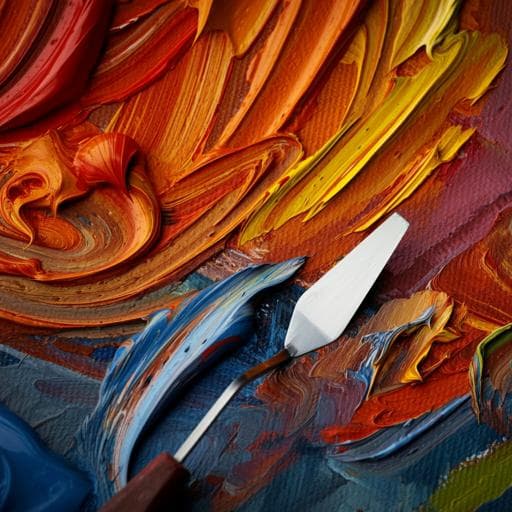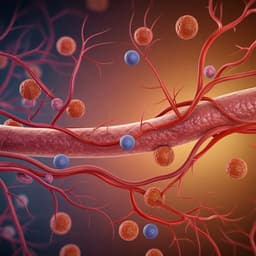
The Arts
A holistic view on the role of egg yolk in Old Masters' oil paints
O. Ranquet, C. Duce, et al.
Discover how egg yolk influences the properties of Old Masters' oil paints in groundbreaking research by Ophélie Ranquet, Celia Duce, Emilia Bramanti, Patrick Dietemann, Ilaria Bonaduce, and Norbert Willenbacher. This study reveals the surprising benefits of egg yolk, from creating ideal paint textures to enhancing long-term stability.
~3 min • Beginner • English
Introduction
The study addresses why and how Old Masters added proteins, particularly egg, to oil paints, and what roles these proteins played in paint preparation, handling, and longevity. Although traditional narratives emphasize oil (and sometimes resins) as binders, analytical studies have detected proteins in historical oil paints by Botticelli, Leonardo da Vinci, Dürer, Vermeer, Rembrandt and others across regions and centuries. This suggests intentional or beneficial use of proteinaceous additives beyond specific pigments or layers, though small amounts often remain unanalyzed. Historical context indicates that while oil paints were known in Italy by the 14th–15th centuries, artists transitioning from egg tempera to oil encountered technical issues (e.g., wrinkling observed in early Leonardo), implying that nuanced paint preparation—beyond simple pigment–oil mixing—was critical. Recipes in medieval sources (e.g., Liber diversarum arcium) reference grinding pigments with water and egg white (glaire) before tempering with oil or gum water, hinting at protein coatings on pigments. The central hypothesis is that incorporating egg yolk, either as a pigment coating or as a secondary liquid, modifies the paint microstructure and thus the rheology (yield stress, brushability, impasto) and curing (oxidation, cross-linking), with implications for paint application, stability, and conservation.
Literature Review
Prior analyses (GC/MS, AAA) identified mixtures of egg proteins and oils in Old Master works, including Botticelli’s Lamentation of Christ where oil layers contain proteins. Treatises like Cennino Cennini describe oil painting but not explicit protein additions to oil paints, likely due to separation of pigment preparation steps; other sources document pigment cleaning/preparation recipes using proteinaceous materials (egg, glue) and polysaccharide gums, especially for blue pigments (azurite, ultramarine). The Liber diversarum arcium includes a direct link between protein addition and oil painting, describing repeated grinding with water and glaire before tempering with oil or gum water, effectively coating pigments with protein. Colloid and rheology literature on capillary suspensions (Koos & Willenbacher and others) provides a framework: small amounts of an immiscible secondary liquid in particle–fluid systems can create percolating particle networks via capillary bridges, drastically increasing yield stress. Prior conservation science shows pigments can catalyze or modulate oil curing (lead white accelerates curing), and wrinkling is affected by pigment content, layer thickness, and drying rates. Antioxidant components in egg yolk (phospholipids, proteins, carotenoids, vitamin E) are known to inhibit lipid peroxidation, suggesting a potential role in altering oil curing and long-term stability.
Methodology
Model paints were formulated using cold-pressed linseed oil (LO), fresh egg yolk (EY), and either lead white (LW, Kremer Pigmente) or synthetic ultramarine blue (UB, Abralux) pigments (X50 ≈ 2 µm; different size distributions). Three paint microstructures were prepared: (1) Oil paint (pure suspension): pigment ground with linseed oil; (2) Capillary suspension (CapS): oil paint with a small amount of EY added and mixed (palette knife), creating a percolating particle network via capillary bridges; (3) Protein-coated pigment (PCP): pigment ground with diluted EY solution, dried to form a protein layer on pigment particles, then dispersed in oil. Paints were typically prepared at solids fraction φ = 32 vol% (including EY solids for PCP; exceptions documented), with film thickness 0.4 mm. Environmental conditions for general experiments: 20 °C, RH 30–50%, with controlled humidity storage for specific tests (<1%, 50%, 76% RH, 20 °C, two weeks). Water uptake by pigments under controlled RH was quantified. Contact angles and interfacial tensions were measured to assess wetting: untreated pigments are well wetted by oil (θUB/LW-LO ≈ 9 ± 2°), EY coating increases oil contact angle (θEY-LO ≈ 38 ± 7°); interfacial tensions ΓO–H2O ≈ 11 mN/m and ΓO–EY ≈ 2 mN/m. Rheology: yield stress σy was determined, and brushstroke profiles/roughness (Rz) from automatically applied strokes were analyzed to relate σy to impasto/levelling; high-shear viscosity behavior considered. Humidity and secondary fluid effects: paints were prepared after pigment storage at specified RH, and secondary fluids (water or EY) were added in defined vol% to induce capillary suspension formation; comparisons made between oil paint, CapS, and PCP at identical φ. Curing/aging studies: Natural air-drying at room conditions; gravimetric mass change over time to track oxygen uptake and subsequent mass loss; differential scanning calorimetry (DSC) under inert atmosphere (75–200 °C) to quantify exothermic peaks from peroxide decomposition/radical recombination; thermogravimetry (TG) to measure mass loss associated with peroxide decomposition; accelerated aging at 80 °C for comparison. Mechanical film formation: periodic surface hardness measurements (pushing a cylindrical piston at constant speed/depth) to identify “dry-to-touch” transition and relate to mass uptake onset. Chemical analysis of cured films: Py/GC/MS to quantify relative amounts of oil polymeric network (m/z 129), azelaic acid (m/z 317), and oleic acid (m/z 339) at 40 and 180 days, normalized to palmitic acid (m/z 313); FTIR (TRANS-FTIR) amide I band deconvolution to monitor secondary structure changes in proteins (PCP systems). Wrinkling tests: visual and photographic assessment of surface morphology for films with varied σy, φ, and EY content, relating wrinkling propensity to yield stress and solids loading. Data collection spanned approximately four years; synthetic UB was used to ensure constant composition across large batches.
Key Findings
- Rheology/impasto: At φ = 32 vol% with 2 vol% EY solids, UB paints showed σy ≈ 10 ± 1 Pa (oil), 21 ± 5 Pa (PCP), and 3075 ± 392 Pa (CapS). Corresponding brushstroke roughness Rz: ≈59–66 µm for oil and PCP; ≈350 µm for CapS, with pronounced brushstroke preservation. Despite increased σy in CapS, high-shear viscosity remained similar to the corresponding binary suspension, preserving brushability at high pigment loading.
- Mechanism: Adding EY as a secondary immiscible phase forms capillary suspensions with percolating fractal particle networks, dramatically raising σy and preventing levelling. In PCP, hydrophilic EY layers on pigment surfaces increase oil contact angle and can induce attractive steric interactions in UB, increasing σy; a hydrophobic coating would instead reduce or eliminate σy (repulsive dispersion).
- Pigment-dependent effects: EY coating increased σy in UB paints with increasing EY content, but decreased or left σy unchanged in LW PCP. LW oil paints are highly sensitive to humidity: storing LW pigment at 76% RH (≈0.6 wt% water uptake) increased σy by nearly two orders of magnitude due to humidity-induced capillary bridge formation. EY coating (≈0.2 µm layer) suppressed humidity-induced CapS formation by distributing water uniformly in the hydrophilic layer, stabilizing σy.
- Tunability: Adding sufficient secondary fluid (water, EY, or other aqueous protein solutions) forms CapS for various pigments, enabling σy tuning over roughly three orders of magnitude. CapS prepared with water had higher σy than with EY, attributed to higher ΓO–H2O versus ΓO–EY; LW CapS showed higher σy than UB CapS due to finer particle fractions.
- Curing kinetics/film formation: Pigments accelerate oil drying: a 0.4 mm linseed oil film took ~70 days to dry; adding 32 vol% pigment reduced drying to ~20 days (UB) and ~4 days (LW). EY addition delayed onset of curing and mass uptake (antioxidant effect of phospholipids, proteins, carotenoids, vitamin E), shifting DSC peroxide decomposition onset to higher temperatures in early aging, particularly for PCP with higher EY content. For UB, CapS and PCP with the same EY solids showed similar latency; for LW, EY distribution mattered: LW CapS dried similarly to LW oil paint (lead dissolution and catalysis maintained), while LW PCP dried more slowly due to an EY “antioxidant shield” delaying lead dissolution and modifying interfacial reaction pathways.
- Chemical network/oxidation: Py/GC/MS showed oil paints at 40 days already have extensive cross-linked networks with notable azelaic acid and residual oleic acid. UB PCP had very low polymeric network at 40 days but increased over time; LW PCP had a well-developed network at 40 days, remaining stable. Overall, EY presence reduced oxidative degradation; TG at 80 °C showed smaller mass loss for UB PCP and LW PCP compared to UB LO and LW LO, indicating preservation of the network.
- Protein structural response: In PCP systems, FTIR analysis indicated significant changes in protein secondary structure (beta, helix, random coil) coincident with peak mass increase (high peroxide concentration), evidencing protein reactivity with oxidizing lipids and potential co-polymerization.
- Wrinkling control: Wrinkling is linked to differential surface/bulk curing and low σy in the still-mobile bulk. At similar modest σy (≈58–75 Pa), both oil paint (φ = 32%) and CapS (φ = 16% + 2 vol% EY) showed comparable wrinkling. Elevating σy to ~3200 ± 400 Pa (φ = 32% with 4 vol% EY) suppressed wrinkling, demonstrating that EY-induced σy control can prevent wrinkling even without high pigment loading.
- Practical implications: Artists could exploit EY to tailor impasto (via σy), mitigate humidity-induced stiffening, fine-tune brushability, delay curing to extend wet-in-wet handling, and reduce wrinkling and oxidative degradation, supporting long-term preservation.
Discussion
The results directly address how and why Old Masters might have incorporated egg into oil paints. Egg yolk alters paint microstructure, enabling two distinct regimes: (i) protein-coated pigments (PCP), where hydrophilic protein layers modulate particle–oil interactions and prevent humidity-induced capillary networks, and (ii) capillary suspensions (CapS), where small amounts of aqueous proteinaceous liquid create capillary bridges that vastly increase yield stress and preserve brushstrokes. This microstructural control allows artists to decouple yield stress (impasto/levelling) from high-shear viscosity (brushability), improving handling at high pigment loadings. EY also acts as an antioxidant, delaying peroxide formation and radical propagation, shifting curing kinetics and pathways; in LW systems, the EY distribution governs access of oil to lead surfaces, modulating catalytic curing. Chemical analyses indicate that EY promotes formation and stability of cross-linked networks that are less prone to oxidative degradation than oil alone, potentially enhancing long-term stability. The study elucidates mechanisms behind humidity sensitivity (notably for LW) and demonstrates that protein coatings suppress unwanted capillary structuring, providing a rationale for historical practices and observed variability in oil paint behavior. Taken together, these insights clarify the multifaceted roles of proteins in historical oil paints, bridging colloidal physics, rheology, and conservation science to explain handling qualities (impasto, wet-in-wet, wrinkling risk) and aging behavior.
Conclusion
This work provides a comprehensive, mechanistic assessment of egg yolk as an additive in oil paints, demonstrating how protein repartition determines microstructure, rheology, and curing chemistry. By comparing protein-coated pigments with capillary suspensions in systems based on lead white and ultramarine blue, the study shows that small amounts of egg yolk can: (i) dramatically increase yield stress via capillary networks to preserve brushstrokes and suppress wrinkling; (ii) modulate particle interactions to improve handling and mitigate humidity-induced stiffening; and (iii) act as an antioxidant, delaying curing onset and fostering well cross-linked networks with reduced oxidative degradation. These findings align with historical evidence of proteinaceous materials in Old Master works and offer practical guidance for understanding and conserving paintings. Future research could extend to additional pigments and binders, quantify broader environmental effects, explore artist-relevant driers or heat-treated oils to balance curing times with desired rheology, and further analyze tempera and tempera grassa systems and their transition behaviors to oil paints.
Limitations
- Model constraints: Synthetic ultramarine was used (not natural), and protein layer thicknesses in PCP (e.g., up to ~2 µm on 2 µm particles, and ~0.2 µm in LW) are not representative of historical paints, serving as colloid-physics models. Only two pigments (LW, UB) and one oil (raw linseed) were studied.
- Analytical scope: Some techniques (e.g., FTIR protein secondary structure) were not applicable to CapS due to low EY content; data availability is on request. Drying times observed for EY-containing formulations can be unrealistically long for artistic practice, though mitigations (driers, heat-treated oils) are known but were not systematically explored here.
- Environmental control: While humidity effects were systematically tested, real workshop conditions vary; long-term natural aging beyond the reported timelines and broader environmental stressors were not fully addressed.
Related Publications
Explore these studies to deepen your understanding of the subject.







